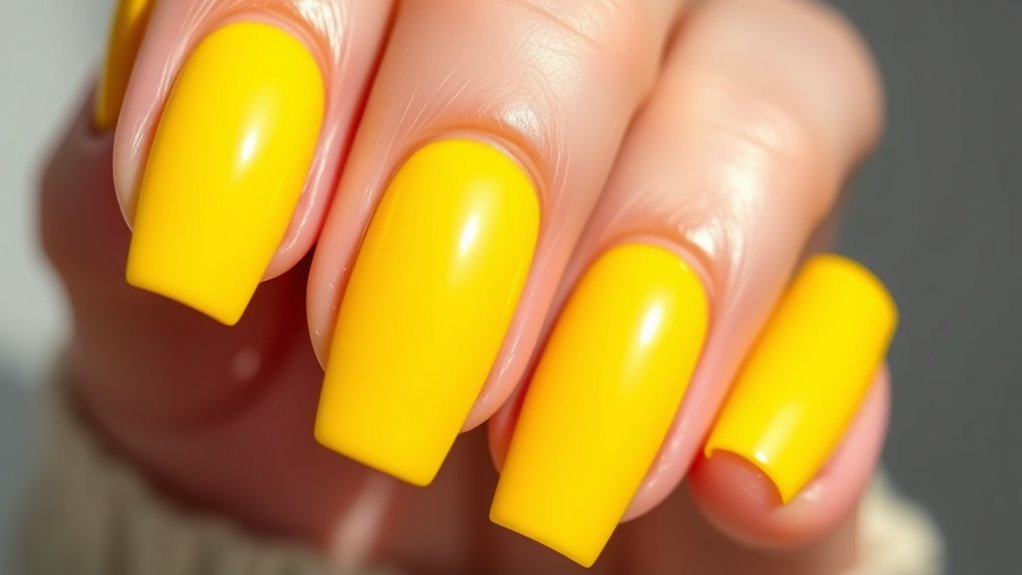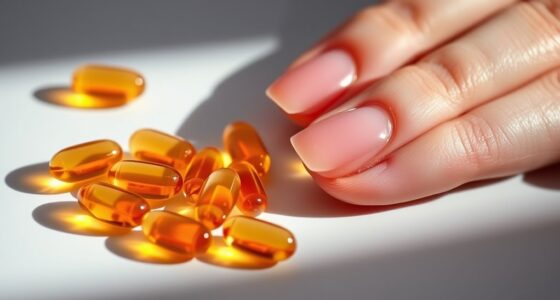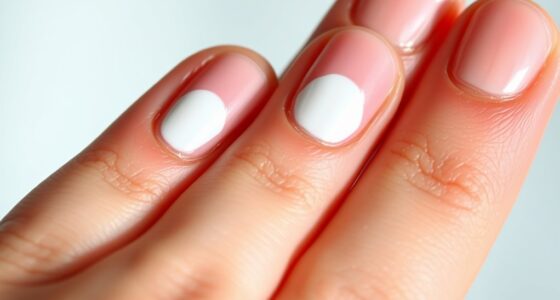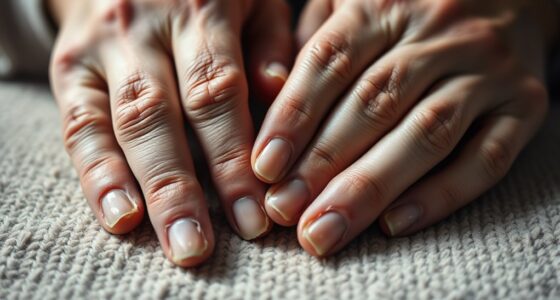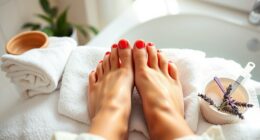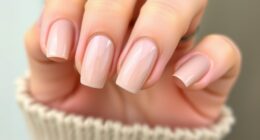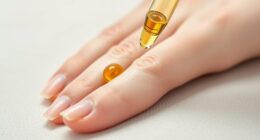Yellow nails often stem from fungal infections, lifestyle habits like smoking, or chemical exposure, which stain or weaken your nails. Poor hygiene and nutrient deficiencies can also cause discoloration. To prevent this, keep your nails clean, dry, and protected with gloves when handling chemicals. Limit nail polish use and give your nails regular breaks. Address underlying health issues and eat nutrient-rich foods for stronger nails. Discover more tips to keep your nails healthy and vibrant.
Key Takeaways
- Fungal infections are a common cause of yellow nails, often accompanied by foul smell and nail crumbling.
- Nutritional deficiencies like lack of biotin, zinc, or vitamin E can weaken nails and cause discoloration.
- Lifestyle habits such as smoking, chemical exposure, and frequent use of dark nail polish contribute to yellowing.
- Maintaining good hygiene, keeping nails dry, and using gloves help prevent fungal growth and staining.
- Address underlying health issues and consult a healthcare professional for persistent or severe yellow nail discoloration.
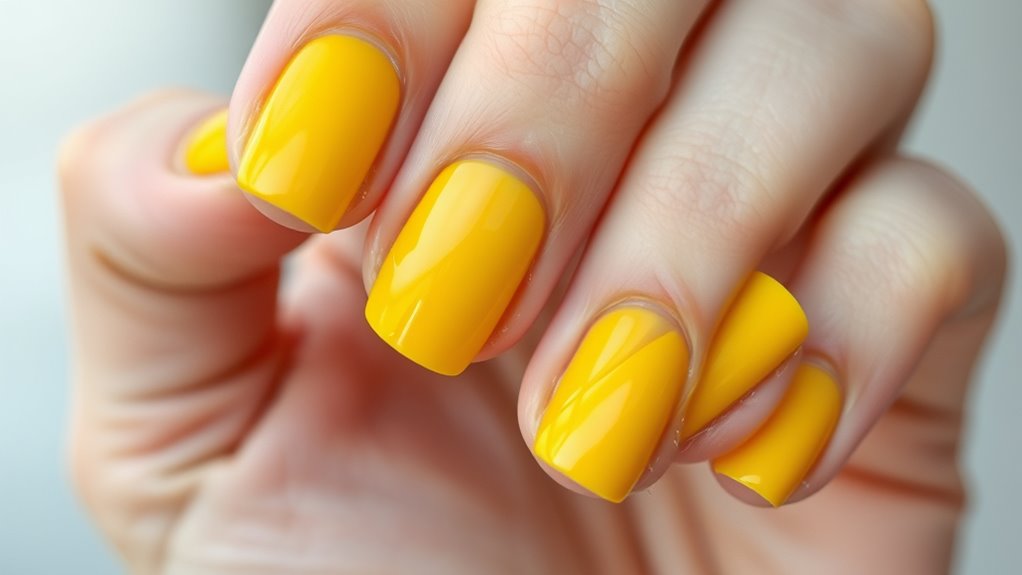
Yellow nails can be more than just a cosmetic concern; they often indicate underlying health issues or lifestyle habits. If your nails have turned a noticeable yellow hue, it’s a sign you should pay attention. One common cause is a nail infection, especially fungal infections, which can cause discoloration, thickening, and brittleness. Fungal infections thrive in warm, moist environments and often start subtly, but over time, they cause your nails to look yellowed and unhealthy. You might notice a foul smell or crumbling edges, which are telltale signs of infection. If you suspect a fungal problem, it’s best to seek treatment promptly, as ignoring it can worsen the discoloration and lead to more serious issues.
Yellow nails often signal fungal infections or underlying health issues needing prompt attention.
Another significant factor behind yellow nails is dietary deficiencies. Your nails require a variety of nutrients to stay healthy and vibrant. A lack of essential vitamins and minerals, such as biotin, zinc, or vitamin E, can lead to weak, discolored nails. For example, a deficiency in biotin often results in brittle, dull nails that may appear yellowish or opaque. Poor nutrition can also impair your body’s ability to produce keratin, the protein that makes up your nails, leading to discoloration and fragility. If your diet lacks fresh fruits, vegetables, or protein sources, you might see the effects reflected in your nails. Improving your diet with nutrient-rich foods can often help restore your nails’ natural color and strength.
Lifestyle habits also play a role. Smoking, for instance, stains nails with tar and nicotine, giving them a yellowish tint. Exposure to certain chemicals or frequent use of nail polish without proper removal can also stain your nails. Additionally, poor hygiene or neglecting to keep your nails clean and dry can promote fungal growth, exacerbating discoloration. To prevent yellow nails, it’s essential to maintain good hygiene, avoid excessive use of dark nail polishes, and give your nails regular breaks from polish and artificial nails.
Incorporating healthy habits can make a big difference. Keep your nails clean and dry, and wear gloves when handling chemicals or cleaning agents. Address dietary deficiencies by eating a balanced diet rich in vitamins and minerals. If you notice persistent yellowing despite these efforts, consult a healthcare professional. They can diagnose underlying issues like fungal infections or nutritional deficiencies and recommend appropriate treatment. Recognizing the signs early and taking proactive steps can help restore your nails’ natural, healthy appearance, preventing further discoloration and damage.
Frequently Asked Questions
Can Yellow Nails Indicate a Serious Health Problem?
Yellow nails can sometimes signal a serious health issue, so you should stay alert to changes in nail health. While it’s often caused by fungal infections or external factors, persistent discoloration might indicate underlying conditions like respiratory issues or diabetes. If your nails stay yellow despite good hygiene, it’s best to consult a healthcare professional. Addressing underlying conditions early can prevent more serious health problems and improve your overall nail health.
Are There Natural Remedies to Whiten Yellow Nails?
You wonder if natural remedies can whiten yellow nails. To improve nail appearance, try home remedies like soaking your nails in a mixture of lemon juice and baking soda, which acts as a natural bleaching agent. Maintaining good nail hygiene is also key; regularly clean and moisturize your nails and cuticles. These simple steps can help brighten your nails without harsh chemicals, promoting healthier, whiter-looking nails over time.
How Long Does It Take to See Improvement After Treatment?
Like a sunrise breaking through stormy clouds, your nail transformation begins to show signs of hope. Usually, you’ll notice improvement within 2-4 weeks as your nails grow out and the discoloration fades. The treatment timeline varies based on nail growth rate and severity, so patience is key. Keep consistent with your efforts, and soon, your nails will shine like polished gems, free from the shadow of yellow stains.
Do Artificial Nails Contribute to Nail Discoloration?
Artificial nails and frequent use of nail polish can definitely contribute to nail discoloration. The chemicals in nail polish, especially darker shades, can stain your natural nails over time. Artificial nails, if not properly maintained, can trap moisture and debris, leading to yellowing or other discoloration. To prevent this, give your nails regular breaks from polish and artificial nails, and always keep them clean and dry.
Is It Safe to Use Over-The-Counter Whitening Products?
You might wonder if over-the-counter whitening products are safe to use. While they often contain chemical ingredients designed to brighten your nails, you should always check product safety labels. Some products could cause irritation or damage if used improperly. It’s best to follow instructions carefully, do a patch test first, and consult a dermatologist if you have sensitive skin or concerns about chemical ingredients.
Conclusion
Now that you know what causes yellow nails and how to prevent them, take charge of your nail health. Think of your nails as a canvas—keeping them clean and moisturized is like choosing vibrant colors over dull shades. With consistent care, you can restore their natural beauty and keep discoloration at bay. Remember, healthy nails are the brushstrokes of confidence—so, paint your nails with care and let your natural beauty shine through.
